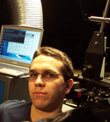|
|
This topic comprises 3 pages: 1 2 3
|
|
Author
|
Topic: FP20 running slow
|
|
|
|
|
|
|
|
|
|
|
|
|
|
|
|
|
|
|
|
|
Rick Long
Jedi Master Film Handler
Posts: 759
From: Toronto, Ontario, Canada
Registered: Nov 1999
|
 posted 02-10-2003 04:06 PM
posted 02-10-2003 04:06 PM




Back during the Sensurround installations (when the speed of the projector (and thus, frequencies derived from the film to trigger the system) had to be reasonably accurate) we used John's method of the 7 1/2 foot loop.
As John points out, it should pass a given point in the projector every 5 seconds. Leave it run for a couple of minutes or so, and you should hear the splice at the same point on your watch. (5, 10 15, or
2, 7, 12, ect.).
| IP: Logged
|
|
|
|
|
|
|
|
|
|
|
|
All times are Central (GMT -6:00)
|
This topic comprises 3 pages: 1 2 3
|
Powered by Infopop Corporation
UBB.classicTM
6.3.1.2
The Film-Tech Forums are designed for various members related to the cinema industry to express their opinions, viewpoints and testimonials on various products, services and events based upon speculation, personal knowledge and factual information through use, therefore all views represented here allow no liability upon the publishers of this web site and the owners of said views assume no liability for any ill will resulting from these postings. The posts made here are for educational as well as entertainment purposes and as such anyone viewing this portion of the website must accept these views as statements of the author of that opinion
and agrees to release the authors from any and all liability.
|

 Home
Home
 Products
Products
 Store
Store
 Forum
Forum
 Warehouse
Warehouse
 Contact Us
Contact Us




 Printer-friendly view of this topic
Printer-friendly view of this topic







![[Roll Eyes]](rolleyes.gif)


![[Big Grin]](biggrin.gif)

![[Smile]](smile.gif)





